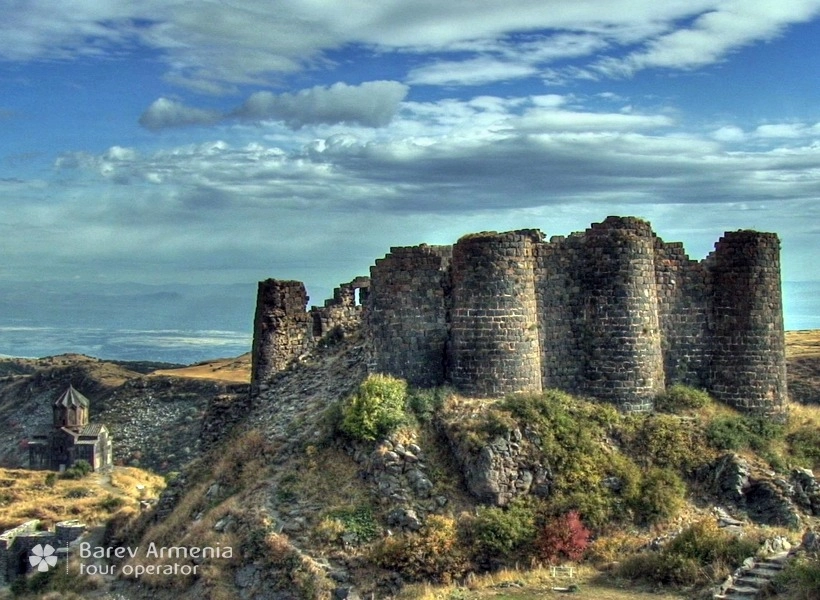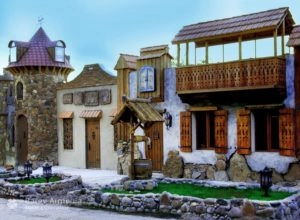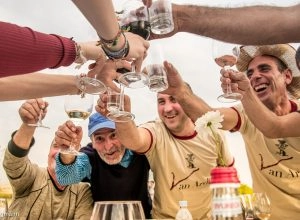Amberd

Location:Aragatsotn
Foundation date: VII c
State: destroyed
From Yerevan: 49km/50m
The Amberd Fortress (VII-X1V c.) was built to the north of Byurakan Observatory at an inaccessible site. Amberd was a powerful fortress in medieval Armenia. T. Toramanyan places Amberd in the same row with the rest of its pristine fortresses. The position of Amberd, as well as the cyclopean fortresses around it, confirm that the fortress existed as early as III-I1 BC.
Amberd was built in X c, at an altitude of 2300 m at the site of an ancient fortress. It had three construction periods: the Bagratounis, the Zakaryans and the Vachoutyans.
Armenia had elaborated and developed unique principles of fortress-construction, which attained perfection in Ambercl. The fortress was founded on a high triangular promontory edged with abysmal gorges and impregnable rocks. Walls, towers and pyramids were built on its less protected parts. The Amberd Fortress was a powerful and finite defense unit.
The citadel, with its dominating position, occupies a unique place in the defense system of Amberd. It is a large 3-storey building. The walls of the lower 2 floors and in certain places of the third floor have been preserved. In the first construction period of the fortress, the external wall of the palace had a circular staircase: the middle one is in a relatively good shape now. In the second period, the facade of the citadel was reinforced with a strong new wall. Outside the wall the rock has a latitudinal cleavage of about 10 m. The resulting deep long hollow complicated the enemy’s advance towards the citadel. The two entrances are small. They were shut with an iron door and locked with logs from behind. The windows of the palace are from the side that looks to the fortress. This had 2 advantages: firstly, the windows were protected by the fortress and, secondly, by looking to the sun, they could receive more light and heat. The window-openings in the ground floor arc narrow and broader – in upper floors. The openings were closed by metal nets and fas-tened with metal rods. The three-storey citadel-palace of Amberd is among the best medieval buildings of the world. When the Vachoutyans made Amberd their administrative centre, they transformed the citadel into a palace.
No fortress was ever built without solving the problem of water supply. Water was transmitted from a distance of 4-5 km with clay pipes. There were 2 tanks: small and large. The smaller one was situated inside the citadel under the floor of one of the rooms. The inside of the tank was covered with a thick layer of water-proof whitewash, the roofing was vaulted. Water was poured from above for which special devices were built oti the roof and the floor. The water pipeline entered the palace and then flew inside the fortress where the larger tank was. This is where water was supplied to the bath and the rest of the fortress.
The secret passageway served as a means for uninterrupted water supply and for communication with the outer world. It was built by using, on the one hand, the natural rocks and, on the other hand, large slabs of stone, which were placed on the opposite side. Then, by placing single-piece slabs on them a regular broad road was built. Human beings or animals carrying water could freely pass there. Special walls were built on top of the opposite rocks with a view to making the entrance to the secret passageway secure and protect it.
The Bath of Amberd is a prominent monument of household construction. It is a vaulted building with hewn stones, a small cloakroom, a large bathroom and heating equipment accommodating the water boiling pot. Water was transmitted to the bath with clay pipes, while hot water was transmitted to the bathroom with iron pipes. The vapour of the furnace flowing under the floor exited through the chimneys on walls heating the floor and walls of the bathroom. Academician H. Orbeli in his work entitled The Bath of XII Century and the Clown opines that die Bath of Amberd existed for many years. Its current condition is the result of a XIT c. transformation, in the course of which the floor of the bath was raised on to tiles to create a hollow space to heat the building with warm air and vapour. The waterpipes are perfect; they were placed side by side and connected with an iron bridge. The technique of connecting iron pipes was among the progressive inventions of the time, since the connection was not done by alloying but by heating them to a melting degree for which a high temperature was required. Another invention of the medieval technology was the regulation of hot and cold waters by means of iron pipes and bronze taps.
Under the floor tiles of a room next to the bath, the archaeologists found a tomb of a clown. Next to it were the bones of his permanent companion -the rooster. In the past, the rooster was the patron of clowns and the earthly symbol of the sun. Orbeli thinks that special surgery had been performed on the clown as a result of which his mouth remained open so that he was always laughing. Noting that the mutilation of clowns was not practiced in the East, Orbeli believes that he was brought from the Western countries.
The Church of Amberd (1026) is at the heart of the fortress. On the outside it has a rectangular, and on the inside a cruciform plan and was built from the local basalt. It is among the first churches that have two-storey sacristies in the 4 comers of cross wings. It has few window openings. The wide windows, typical of the early medieval Armenian monuments, narrow down starting from X c. and their number decreases.
From the constructional point of view, the church is magnificent: there is no difference of even 1 cm between the external and internal walls and the diagonals. To make the roof lighter and to enhance the acoustics, large and small clay bowels were used in the mortar of the roof. Metal rods were also used in the construction to fortify the stones of cornices.
The austere and pure style of the Church of Amberd endured the devastating hand of the time and preserved its force of aesthetic impact.
The Amberd Fortress has seen innumerable invasions. In XI c, it was conquered by Seijuks, in XT11 c. by Mongols and then leveled by Turkic Tatars. The fortress was abandoned after Timur the Lame’s invasion in XIV c.







